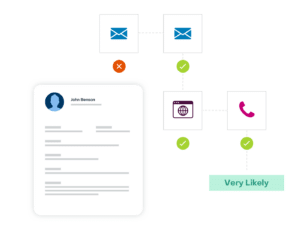5 Problems Caused by Sales and Marketing Misalignment
Sales and Marketing; they’re like the perfect couple. One is analytical and direct, while the other does all the talking and appeals to the emotions. When they’re in perfect alignment, life is good.
That’s how it is with sales and marketing. But like couples, they have disagreements sometimes. If left unresolved, these disagreements can create misalignment, miscommunication, demotivation, and eventual failure to grow the business.
What is Sales and Marketing Misalignment?
Misalignment between sales and marketing is exactly what it sounds like. It occurs when each team’s poor communication, untethered goals, and lack of accountability lead to underperformance.
Sometimes, sales and marketing misalignment creates a lack of respect for each team’s work and investment. Worse, it can even result in a negative culture across the business.
How Can You Tell if Your Marketing and Sales Teams are Misaligned?
Sales and marketing team members can generally sense when they’re off-kilter. There’s a tension—a palpable energy. Ever experienced any of these tell-tale signs?
- Sales claim the leads are low quality.
- Sales automatically disqualify a large number of leads from marketing without consideration.
- Customers don’t engage with marketing content despite significant spend.
- Sales ignore available marketing content.
- Sales and marketing leaders don’t meet regularly.
Aligning sales and marketing isn’t just about keeping the peace. Misalignment has real (and potentially detrimental) consequences.
If marketing doesn’t produce solid content, it can’t capture quality leads to pass to sales. If sales don’t have quality leads to work with, it can’t close deals. Ultimately, this results in unsuccessful campaigns, failed products, and loss of revenue to invest in better solutions. See the problem?
5 Ways to Increase Sales and Marketing Alignment
First, stop pointing fingers. Both teams have a part to play in achieving company targets. Solving misalignment starts with aligning—across communication, goals, incentives, and views.
1. Communicate regularly and invite feedback.
No one is a mind reader. The only way for a team to improve is if they know what to improve upon. Schedule recurring team meetings, especially between leaders, to discuss goals and tactics. Work directly with marketers to modify content for the ultimate relevance. Ask sales what they need. Invest in a communication platform to make it easier to collaborate virtually. Be willing to accept feedback and adopt an agile mindset to anticipate changes and cater to the needs of each team. Prioritize the common goal over individual egos.
2. Set achievable goals—together.
Perhaps the biggest sign that sales and marketing aren’t jiving is that neither team meets its goals. This is usually because they don’t set them together. Yet achieving common outcomes (i.e., increased revenue) will never happen if there’s no alignment to get there. Work together to set each other up for success: if sales target 50 closed deals, how many leads will marketing have to supply to get there? Use past data and experience to work backward, so the chips fall in the right direction throughout the quarter.
Don’t forget to identify common terminology and KPIs. What makes a “quality lead?” What is an MQL? What is an SQL? Plus, make sure your goals are SMART—specific, measurable, attainable, realistic, and time-bound. Then, display them prominently and/or ensure both teams have access to common dashboards to check progress regularly.
3. Motivate and incentivize properly.
Sales and marketing studies indicate that misaligned incentives and pricing structures are the main cause of sales demotivation. If a company launches a new product but places incentives on existing solutions, sales will focus more on the ones that align with their goals, risking product success and even sacrificing company profits. This is why it’s important to align not only sales to marketing but to top-line company goals as well.
Sales acceptance and subsequent success with MQLs play a large part in marketing motivation. If marketing does the work to qualify and deliver leads, but sales dismiss them, they won’t be motivated to provide quality contacts.
4. Align messaging.
It’s hard to sell one product when marketing another. Marketers often take a set-it-and-forget-it approach to content, leaving it to “work its magic” once launched. But audiences change, and messages sometimes fall on deaf ears. Be willing to change content that will benefit sales in their conversations and pitching. To further ensure alignment, provide sales with the messaging materials they need, like nurture emails, pitch decks, blogs to reference, customer success stories, etc. Teach them how to speak knowledgeably and on-brand about the products you promote.
5. Check back in.
The sales and marketing relationship is never finished. It requires constant care and realignment. Take time to review outcomes and identify:
- What worked?
- What didn’t?
- Where could we improve?
- What do sales need from marketing to do better? Vice versa?
These insights will then inform the next round of goals to be more achievable.
Obtain a Common Sales and Marketing View
Is there hope for sales and marketing? Of course. When they can easily communicate and see each other’s point of view, everyone has the insight they need to achieve their goals.
SugarCRM provides a single place for sales and marketing to collaborate over accounts, communicate, and check progress on goals. With intelligent sales and marketing, you can paint a complete picture of every lead: where they’ve been, who they’ve talked to, and what they need to convert. Plus, each team has the tools it needs to accomplish specific tasks:
- Attract visitors across digital spaces.
- Gain visibility into how they interact with digital assets.
- Capture leads when they’re at their hottest.
- Create conversion-focused emails, landing pages, and forms.
- Cultivate and qualify leads with multi-step nurture campaigns and sophisticated lead scoring models.
- Leverage automation to reduce repetitive tasks and easily hand qualified leads to sales.
- Deliver AI-powered predictions about your customers, even with limited or incomplete CRM data.
- Tailor your CRM with platform customization, workflow, and integration capabilities.
- Gain insight into how customers got to their current state with a complete journey record.
- Make sense of lead behavior with historical data and analytics tools.
Plus, experience seamless interoperability to deliver high-definition customer experiences (HD-CX) that win more deals. When you integrate Sugar Market and Sugar Sell, you can achieve a clear view at a fraction of the cost elsewhere.
Want to learn more about the costs of sales and marketing misalignment? Check out our guide, Sales + Marketing: Better Together.
Experience the power of true sales and marketing alignment. Get the visibility you both need by watching our platform demo today.



